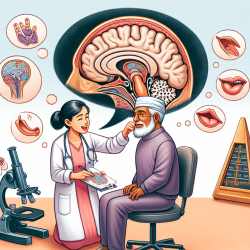Introduction
In the realm of speech-language pathology, understanding the genetic underpinnings of neurodegenerative diseases like Progressive Supranuclear Palsy (PSP) can significantly enhance therapeutic approaches and outcomes. The recent research article titled Whole-genome sequencing analysis reveals new susceptibility loci and structural variants associated with progressive supranuclear palsy offers groundbreaking insights into the genetic architecture of PSP. This blog explores how practitioners can leverage these findings to improve therapeutic strategies and encourages further research in this domain.
Understanding PSP and Its Genetic Landscape
PSP is a rare neurodegenerative disorder characterized by the accumulation of tau proteins, leading to various motor and cognitive impairments. Traditionally, the genetic studies of PSP have focused on common variants, but this new research employs whole-genome sequencing (WGS) to uncover both common and rare genetic variants, offering a more comprehensive understanding of the disease.
Key Findings from the Research
The study analyzed a cohort of 1,718 PSP cases and 2,944 controls, identifying novel genetic loci and structural variants associated with PSP. Notably, the research highlights:
- The confirmation of known genetic loci such as MAPT, MOBP, and STX6.
- Identification of new signals in genes like APOE, FCHO1/MAP1S, and KIF13A.
- Rare variants in ZNF592 and structural variants in regions such as the H1/H2 haplotype.
Implications for Speech-Language Pathology
For practitioners, these findings underscore the importance of a genetic perspective in managing PSP. By understanding the genetic predispositions, speech-language pathologists can tailor interventions more effectively. For instance, knowing a patient’s genetic profile can help anticipate the progression of speech and language impairments, allowing for proactive therapeutic measures.
Moreover, the identification of the APOE gene's role in PSP provides a potential biomarker for early diagnosis and intervention, which is crucial for improving patient outcomes.
Encouraging Further Research
This study opens new avenues for research, particularly in exploring how these genetic variants influence PSP's clinical manifestations. Practitioners are encouraged to collaborate with geneticists and researchers to integrate these findings into clinical practice, potentially leading to personalized therapy plans that cater to individual genetic profiles.
Conclusion
The integration of genetic research into speech-language pathology offers promising prospects for managing PSP. By adopting a data-driven approach and staying abreast of genetic advancements, practitioners can enhance therapeutic outcomes and contribute to the broader understanding of neurodegenerative diseases.
To read the original research paper, please follow this link: Whole-genome sequencing analysis reveals new susceptibility loci and structural variants associated with progressive supranuclear palsy.










